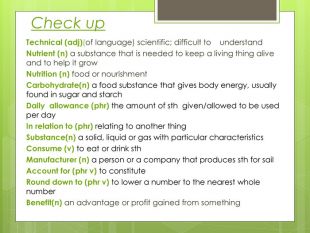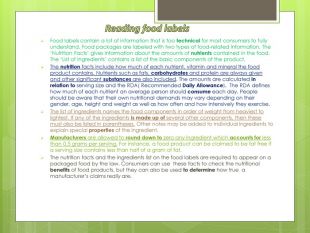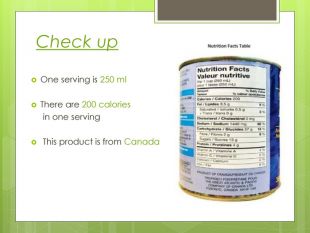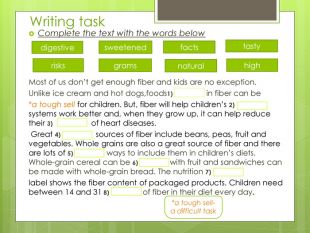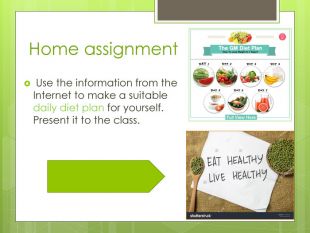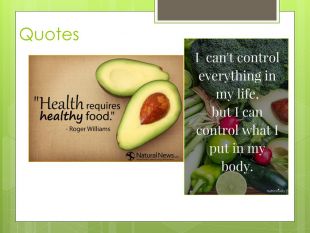Презентація 'Building up healthy eating habits'























Objectives. To improve reading skills regarding to food label identification. To develop communication skills in relation to building up healthy eating habits. To develop listening skills : to develop healthy lifestyle thinking while working on video material about the role of fiber foods in kids 'diet To develop social competence: to formulate own position ● to cooperate with others to achieve certain results, communicating on healthy eating issues ● to persuade, argue, achieve mutual understanding /a compromise in discussion regardingfood pyramid designs while doing projects
Outcomes. Students will be able to:understand the text they read regarding to food label identification;cooperate with others to achieve certain results, communicating about building up healthy eating habits;understand video material about the role of fiber foods in kids 'diet and have developed healthy lifestyle thinking; persuade, argue, achieve mutual understanding /a compromise in discussion regarding food pyramid designs while doing projects
Lead-in High-fiber bread a whole wheat or whole grain bread that is enriched with extra fiber Lean meats are meats with a relatively low fat content Canola oil is oil made from crushed canola seeds Refined flour containing much of the nutritional fiber and vitamins removed and is often referred to as "white flour“ Solid fats
Tips for healthy eating Eat a variety of vegetables, especially dark green, red, and orange vegetables Eat whole-grain, high-fiber breads and cereals (3 to 6 servings a day)Drink fat-free or low-fat milk and eat low-fat dairy products. Choose from a variety of low-fat sources of protein — including eggs, beans, poultry without skin, seafood, lean meats, unsalted nuts, seeds, and soy products. Use vegetable oils (like olive or canola oil) instead of solid fats. Restrict or eliminate "junk food" — foods that contain refined white flour, solid fats or trans fats, added sugars, and are high in sodium. Talking points
Vocabulary introduction. I. Match the word or phrase to its definition. Technical (adj) Nutrient (n)Nutrition (n) Carbohydrate(n) Daily allowance (phr) In relation to (phr) Substance(n) Consume (v) Manufacturer (n) Account for (phr v) Round down to (phr v) Benefit (n)food or nourishmenta food substance that gives body energya substance that is needed to keep a living thing alive and to help it growa solid, liquid or gas with particular characteristicsrelating to another thingto eat or drink sththe amount of sth given/allowed to be used per dayto lower a number to the nearest whole number (of language) scientific; difficult to understanda person or a company that produces sth for sailan advantage or profit gained from somethingto constitute
Check up Technical (adj)(of language) scientific; difficult to understand. Nutrient (n) a substance that is needed to keep a living thing alive and to help it grow. Nutrition (n) food or nourishment. Carbohydrate(n) a food substance that gives body energy, usually found in sugar and starch. Daily allowance (phr) the amount of sth given/allowed to be used per day. In relation to (phr) relating to another thing. Substance(n) a solid, liquid or gas with particular characteristics. Consume (v) to eat or drink sth. Manufacturer (n) a person or a company that produces sth for sail. Account for (phr v) to constitute. Round down to (phr v) to lower a number to the nearest whole number Benefit(n) an advantage or profit gained from something
Reading food labels. Food labels contain a lot of information that is too technical for most consumers to fully understand. Food packages are labeled with two types of food-related information. The ‘Nutrition Facts’ gives information about the amounts of nutrients contained in the food. The ‘List of Ingredients’ contains a list of the basic components of the product. The nutrition facts include how much of each nutrient, vitamin and mineral the food product contains. Nutrients such as fats, carbohydrates and protein are always given and other significant substances are also included. The amounts are calculated in relation to serving size and the RDA( Recommended Daily Allowance). The RDA defines how much of each nutrient an average person should consume each day. People should be aware that their own nutritional demands may vary depending on their gender, age, height and weight as well as how often and how intensively they exercise. The list of ingredients names the food components in order of weight from heaviest to lightest. If any of the ingredients is made up of several other components, then these must also be listed in parentheses. Other notes may be added to individual ingredients to explain special properties of the ingredient. Manufacturers are allowed to round down to zero any ingredient which accounts for less than 0.5 grams per serving. For instance, a food product can be claimed to be fat free if a serving size contains less than half of a gram of fat. The nutrition facts and the ingredients list on the food labels are required to appear on a packaged food by the law. Consumers can use these facts to check the nutritional benefits of food products, but they can also be used to determine how true a manufacturer’s claims really are.
Video discussion. Why is *fiber important for our body?What are the natural sources of fiber?What are the ways to work fiber into your child’s diet?Fiber is simply a type of carbohydrate found naturally in plant-based foods that is not digestible in humans. Videohttps://www.youtube.com/watch?v=rc. NC8xq. VC8 I
Writing task Complete the text with the words below. Most of us don’t get enough fiber and kids are no exception. Unlike ice cream and hot dogs,foods1) in fiber can be *a tough sell for children. But, fiber will help children’s 2) systems work better and, when they grow up, it can help reduce their 3) of heart diseases. Great 4) sources of fiber include beans, peas, fruit and vegetables. Whole grains are also a great source of fiber and there are lots of 5) ways to include them in children’s diets. Whole-grain cereal can be 6) with fruit and sandwiches can be made with whole-grain bread. The nutrition 7)label shows the fiber content of packaged products. Children need between 14 and 31 8) of fiber in their diet every day.digestivefactsrisksgramsnaturalsweetenedtastyhigh*a tough sell- a difficult task
Project work. Group A are into healthy eating habits. You have to make a healthy food pyramid. Prove your point. Group B you are into junk food. Your task is to make an unhealthy food pyramid. Persuade your opponents. Group C you are into healthy eating while exercising. You have to make a healthy food pyramid. Prove your point. Use the information you’ve heard and read to be convincing. Be creative! Make some notes to be prepared Be tolerant to your opponents !


про публікацію авторської розробки
Додати розробку









